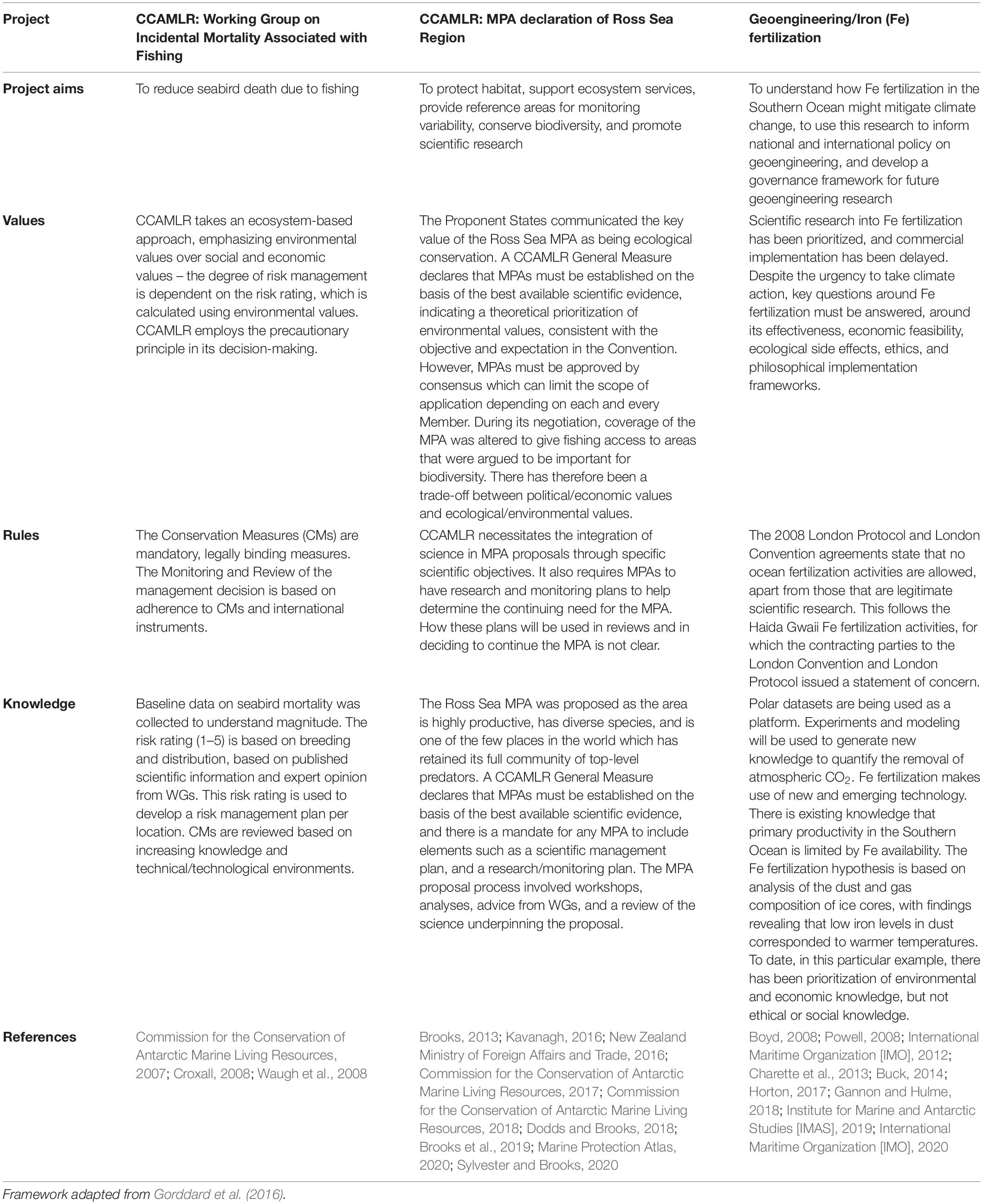Stakeholder Engagement in Decision Making and Pathways of Influence for Southern Ocean Ecosystem Services
- 1Faculty of Science, Monash University, Clayton, VIC, Australia
- 2CSIRO Oceans and Atmosphere, Hobart, TAS, Australia
- 3Centre for Marine Socioecology, University of Tasmania, Hobart, TAS, Australia
- 4Australian Antarctic Division, Kingston, TAS, Australia
- 5Institute for Marine and Antarctic Studies, University of Tasmania, Hobart, TAS, Australia
Southern Ocean ecosystem management is characterized by a unique and complex international network of stakeholders and stakeholder relationships (a ‘transactional landscape’) relating to the globally significant services that these ecosystems support. This transactional landscape spans governments, industry (fishing and tourism), scientific research, conservation non-government organizations, civil society, and international decision-making forums. We used a network approach for stakeholder mapping to provide the first description of the transactional landscape for Southern Ocean ecosystem management – both in terms of the connections between stakeholders and ecosystem services, and directly between stakeholder groups. We considered 65 stakeholders and their relationships to 12 provisioning, regulating, supporting and cultural ecosystem services. An analysis of the connections within this network reveals differences in the degree of connectivity between stakeholders and ecosystem services. Notably, ecosystem science facilitates high connectivity between stakeholders and provisioning services, but there is little connectivity between stakeholders and supporting services. We then applied a formal ‘values-rules-knowledge’ framework to a set of case studies to analyze the decision-making process in relation to Southern Ocean ecosystem services, as well as the relative importance of different stakeholder groups which were considered in the network analysis. Our analyses suggest that emphases for decision making have been on knowledge and rules, but that wider consideration of values across the broader stakeholder landscape – together with science (knowledge) and governance (rules) – might better support decision making for Southern Ocean ecosystem conservation and management, and provide a stronger foundation for sustainable provision of ecosystem services into the future.
Introduction
Southern Ocean ecosystems support a range of ecosystem services that are significant at a global scale (Grant et al., 2013; Rogers et al., 2020; Trebilco et al., 2020). Ecosystem services are the benefits that people derive from functioning ecosystems (Costanza et al., 1997; Millennium Ecosystem Assessment [MEA], 2005), and are generally classified as provisioning, regulating, supporting and cultural. For the Southern Ocean, these include, amongst others, fisheries products, genetic resources, biochemical and pharmaceuticals (all provisioning services); climate and air quality regulation (regulating services); photosynthesis, primary production and nutrient cycling (supporting services); tourism, recreation, and spiritual, religious and aesthetic value (cultural services) (Grant et al., 2013). These services are managed at an international level. This management is characterized by stakeholders from governments, the fishing and tourism industry, scientific researchers and advisors, conservation non-government organizations, civil society, and international decision-making forums. Importantly, the Southern Ocean is amongst the most rapidly changing oceans of the world, with consequences for global-scale storage and cycling of heat and carbon, major changes in habitats, and combined flow-on effects for habitats and ecosystems (Meredith et al., 2019). In order to manage these future dynamics, it will be critical to have approaches that are flexible and adaptive to the changing pressures and can meet the challenges of satisficing the competing needs of the stakeholders whilst conserving biodiversity and ecosystem function in the Southern Ocean (Constable et al., 2017). Understanding the relationships between stakeholders and the services they wish to sustain is fundamental to meeting the challenge.
The Southern Ocean is governed by the Antarctic Treaty System (ATS), which encompasses a series of international agreements that protect ecosystems south of 60°S and recognize the importance of Antarctic ecosystems to people in terms of their wilderness and aesthetic value, and value to scientific research (Antarctic Treaty System, 2020). The main governance structure within the ATS is the Antarctic Treaty Consultative Meeting (ATCM), with the aim of formulating and recommending further measures to their respective governments in accordance with the goals of the ATS (Antarctic Treaty System, 2020). This meeting is held annually, consisting of 29 Consultative Parties (including original 12 signatories to the ATS, and 17 additional countries who have conducted substantial research in Antarctica), 25 Non-Consultative Parties, observers, including the Convention of the Conservation of Antarctic Marine Living Resources (CCAMLR) and the Scientific Committee on Antarctic Research (SCAR), and invited experts (Antarctic Treaty System, 2020). While all these groups may be present in the ATCM, only Consultative Parties play a role in decision-making (Antarctic Treaty System, 2020).
Within the ATS, CCAMLR, takes an ecosystem approach to the management of fishing activities in the Southern Ocean (Constable et al., 2000; Constable, 2011), and extends to the north the jurisdiction of the ATS to include biota and ecosystems south of the Polar Front. CCAMLR is generally recognized as having a strong foundation of decision-making based on best available science and using a precautionary approach to ecosystem management (Parkes, 2000; Miller, 2011). In 2016, CCAMLR declared the world’s largest marine protected area in the Ross Sea, measuring 1.5 million square kilometers in size (Dodds and Brooks, 2018). However, in recent years progress has stalled in meeting the CCAMLR Commission’s commitment to the implementation of the network of marine protected areas in the Southern Ocean, and progress toward determining approaches to incorporate climate change into ecosystem management has also been slow (Brooks et al., 2019). While the continued uptake of scientific information through the ATS and CCAMLR will be critical to progressing these issues, attention to understanding stakeholder values and needs has been lacking; this is despite the fact that decision making in the ATS must be achieved through consensus, which is dependent upon satisfactorily negotiating these requirements.
Recent assessments have helped to build a clearer understanding of the links between environmental change, ecological process and functions, and associated risks for continued delivery of Southern Ocean ecosystem services; these assessments were conducted in the contexts of anticipated changes in demand and climate change impacts (Rogers et al., 2020; Trebilco et al., 2020; Cavanagh et al., 2021). However, the human dimensions that determine how and where ecosystem services are valued and used are arguably much less well understood. Stakeholder mapping is an approach increasingly used in environmental management and governance to consider the various parties interested in a system, and to analyze their relationships both with the system and with each other (Raum, 2018). The stakeholders which were considered include all individuals or groups, whether formal or informal, “who affect, and/or are affected by, the policies, decisions and actions of the system” (Grimble et al., 1995, p. 3). To date, there has been no systematic stakeholder mapping for the Southern Ocean and only scattered information is available regarding connections between stakeholders and their relationships to ecosystem services, which we refer to as a ‘transactional landscape.’ This is somewhat surprising given the unique nature of the Southern Ocean stakeholder landscape, in that there are no permanent residents of the Southern Ocean and the Antarctic continent, and no Traditional Owners (Aboriginal peoples) for Antarctica or most subantarctic islands. As a result, strategies for sustaining all ecosystem services within an international governance framework need to understand how governments interact and the role that different stakeholders may play in influencing outcomes.
In this study we use structured approaches to develop a network representation of the transactional landscape of the Southern Ocean. This network representation of the transactional landscape enables us to visualize parts of the landscape that are most and least connected. We then consider how this mapping relates to decision making processes for Southern Ocean ecosystems using case studies and the values-rules-knowledge (vrk) framework (Gorddard et al., 2016). Through applying this framework, we expect to identify the influence of values, rules and knowledge on decision making, and whether any of these three systems has been excluded from decision making processes. We expect that this will provide useful information for identifying ways in which stakeholder values, scientific knowledge and governance frameworks might be more effectively combined to overcome issues currently facing ecosystem management for the Southern Ocean.
Materials and Methods
Our methodology followed four steps, detailed in the subsections below. Namely:
(1) Identifying stakeholders for Southern Ocean ecosystems and the ecosystem services they have an interest in.
(2) Creating an interest-influence matrix to explore the relationship between stakeholders and ecosystem services.
(3) Analyzing the relationship between the stakeholders and ecosystem management decision-making through a network mapping approach.
(4) Applying the values-rules-knowledge framework to three case studies of Southern Ocean ecosystem management, to contextualize the relationships between stakeholders and ecosystem services and test our network mapping.
Data Collection
We developed an initial list of stakeholders for Southern Ocean ecosystems from the stakeholder list for the Marine Ecosystem Assessment for the Southern Ocean (MEASO) Science Network (Constable et al. in preparation). Other stakeholders were added iteratively to the stakeholder list if they were mentioned in the strategic reports and websites of stakeholders already on the list. Key players in unrepresented industries on the MEASO Science Network, such as the largest private fisheries in the Southern Ocean, and governing bodies in the fisheries and tourism industries, were also added to the list (Commission for the Conservation of Antarctic Marine Living Resources, 2019). In total, 64 stakeholders with an interest in Southern Ocean ecosystem management were identified. Of these, 29 stakeholders are sub-groups or sub-organizations of a parent stakeholder (e.g., SC-CAMLR is part of CCAMLR but plays a significant role as a specific body), but were analyzed separately due to their own interests in, or influence over, specific ecosystem services.
We identified the ecosystem services present in the Southern Ocean based on research by Grant et al. (2013), which explored provisioning, regulating, supporting and cultural ecosystem services (following the Millennium Ecosystem Assessment framework for ecosystem services; Millennium Ecosystem Assessment [MEA], 2005; Table 1).
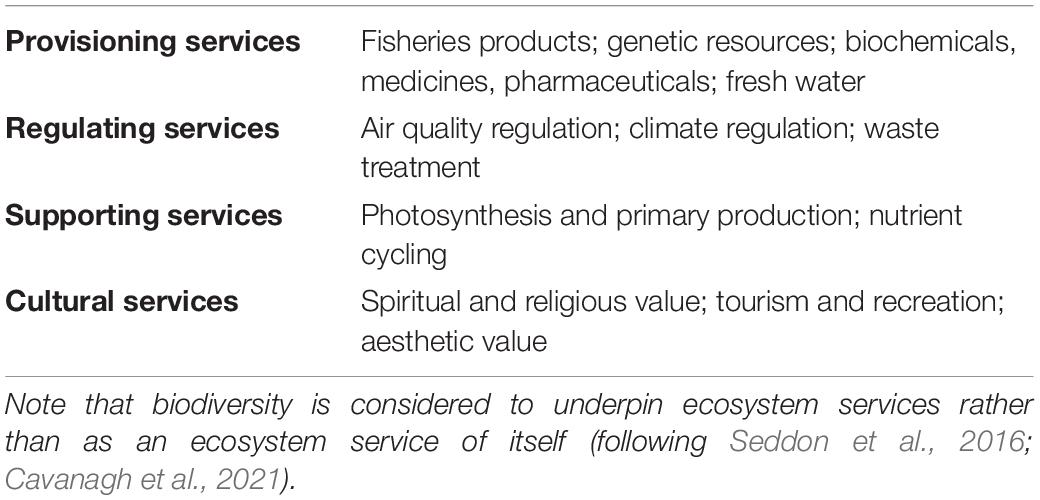
Table 1. A summary of the ecosystem services in the Southern Ocean, adapted from Grant et al. (2013).
We then conducted a thorough analysis of the stakeholders’ motivations, interests, aims, actions and strategies, to understand their connection to ecosystem services in the Southern Ocean. This was done through close reading of annual reports, strategic plans, and key documents listed on organizational websites for our list of stakeholders (these resources are detailed in Supplementary Table 1). The scope of webpages and documents examined to understand each stakeholder’s motivations, interests, aims, actions and strategies varied; this depended on each stakeholder’s information management on their website, and where specific information was located.
We linked each stakeholder to the specific ecosystem services they have an interest in. Stakeholders were defined as having an interest in an ecosystem service if they have one or more of the following relationships with it: produce, use, regulate, research, monitor (note here that the ‘regulate’ relationship refers to management, and can be for any ecosystem service, not just ‘regulating’ services). The ‘produce,’ ‘use,’ and ‘regulate’ relationships were determined following the methodology used by Raum (2018) in categorizing forest management stakeholders into these three groups based on their functional roles. The ‘research’ and ‘monitor’ categories were added for our Southern Ocean context to differentiate stakeholders whose relationship to ecosystem services is purely research, versus those who do not undertake research directly (i.e., non-research scientific organizations) but instead undertake monitoring and assessment activities.
Interest-Influence Matrix
We created an interest-influence matrix to explore in greater depth the relationships between stakeholders and ecosystem services (following Raum, 2018; see Supplementary Table 2). Stakeholders’ levels of interest and influence were categorized as low, medium, or high. The level of interest in an ecosystem service was determined by how closely stakeholders’ actions aligned with a particular ecosystem service (following Raum, 2018). The level of influence was defined as the ability a stakeholder has to affect specific ecosystem services, either directly or indirectly, through use, production, regulation, research and/or monitoring.
To summarize the interest-influence matrix, we categorized stakeholders under their broad industries, as science organizations (research, ecology, or monitoring organizations), regional bodies and regulators, international bodies and regulators, fisheries, lobby groups, or tourism and the public. Using the interest-influence matrix, we also assigned them functional roles based on their work with particular ecosystem services, as producers, users, regulators, researchers, or observers, following Raum’s (2018) process:
• Producers were defined as those stakeholders who produce goods or services through particular ecosystem services.
• Users are the stakeholders which passively use or benefit from the use of particular ecosystem services.
• Regulators are those stakeholders with the ability to set either formal or informal rules to govern the actions of other stakeholders in relation to ecosystem services.
• Researchers were defined as any stakeholder which engages in science research and understanding, including modeling, but excluding monitoring and observing.
• Monitors are the stakeholders which engage in scientific monitoring and observing of particular ecosystem services, and inform other stakeholders.
Relationship Mapping
We used a network mapping approach to visualize the relationship between stakeholders and ecosystem management, in particular the decision-making process. First, stakeholders in their broad industries were mapped against the four key types of ecosystem services – provisioning, regulating, supporting, and cultural – based on their functional role toward, and level of interest in, these ecosystem services (Figure 1). The aim of this network visualization was to identify: (i) the relative strength of connectivity between stakeholders and each of the four key ecosystem services, and (ii) whether any services were under-represented or over-represented in terms of connection to stakeholders.
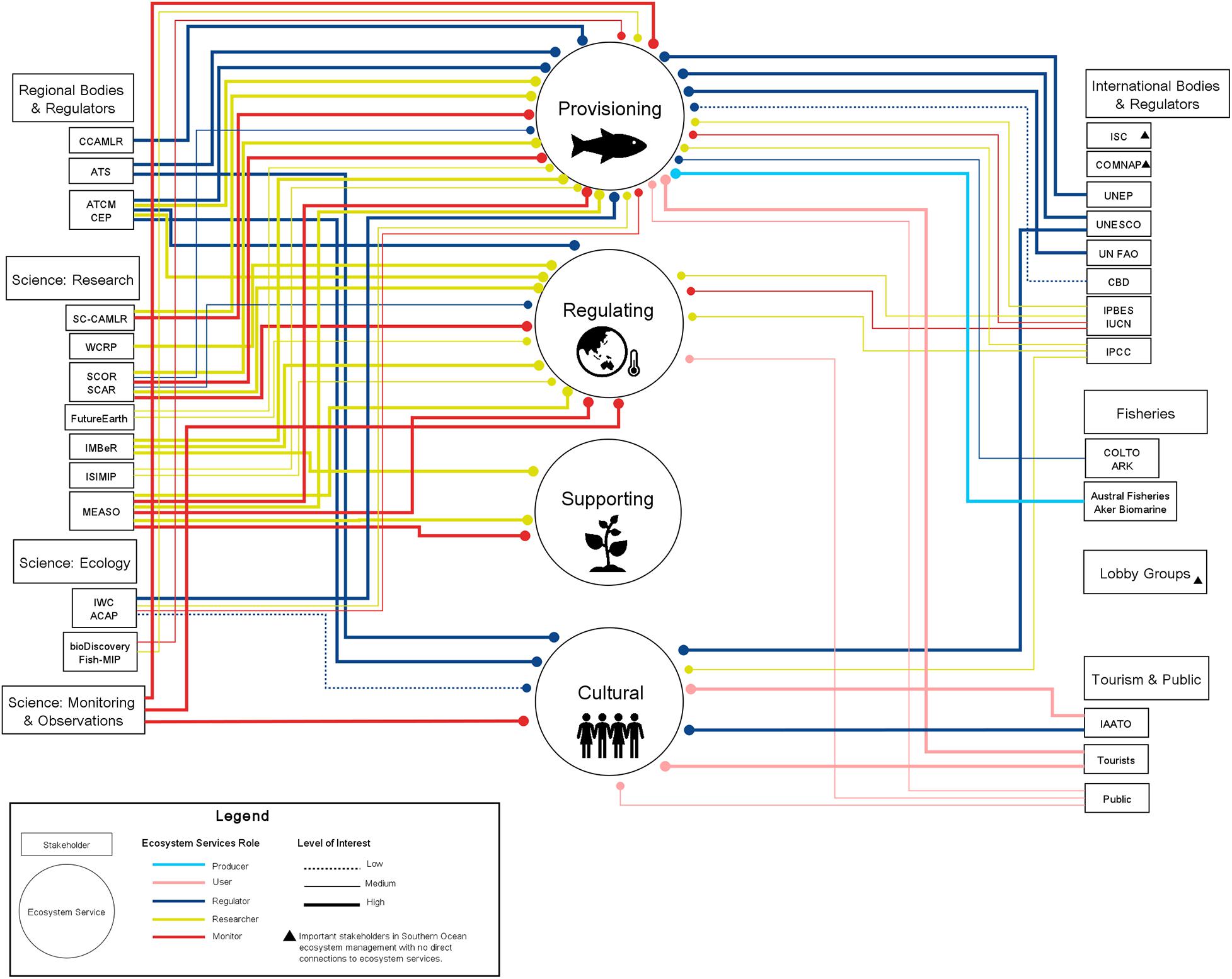
Figure 1. A network visualization of the transactional landscape for stakeholders and ecosystem services in the Southern Ocean. Colored lines show the role that stakeholders perform, with respect to each service they are connected to, and the weight of the lines represents their relative level of interest in a particular service.
We then visualized the relationship between stakeholders to understand how various stakeholders regulate, advise, fund, and support one another. Individual stakeholders were separated based on their functional role to understand how stakeholders with different roles interact with each other. To reduce overlap in the network visualization, some stakeholders were grouped together with their parent stakeholders when they performed the same roles and had the same level of interest in ecosystem services (for example, the SC-CAMLR scientific working groups WG-EMM, WG-SAM, and WG-FSA were grouped together with their parent stakeholder, SC-CAMLR). As a result, 38 different stakeholders or stakeholder groups, including some stakeholders which are sub-groups of others but which perform different roles or have a different level of interest to their parent groups, were included in the network visualization.
Based on these two visualizations, we created a conceptual diagram (Figure 2) to demonstrate the influence pathway between key stakeholder groups, and how ecosystem services influence decision-making.
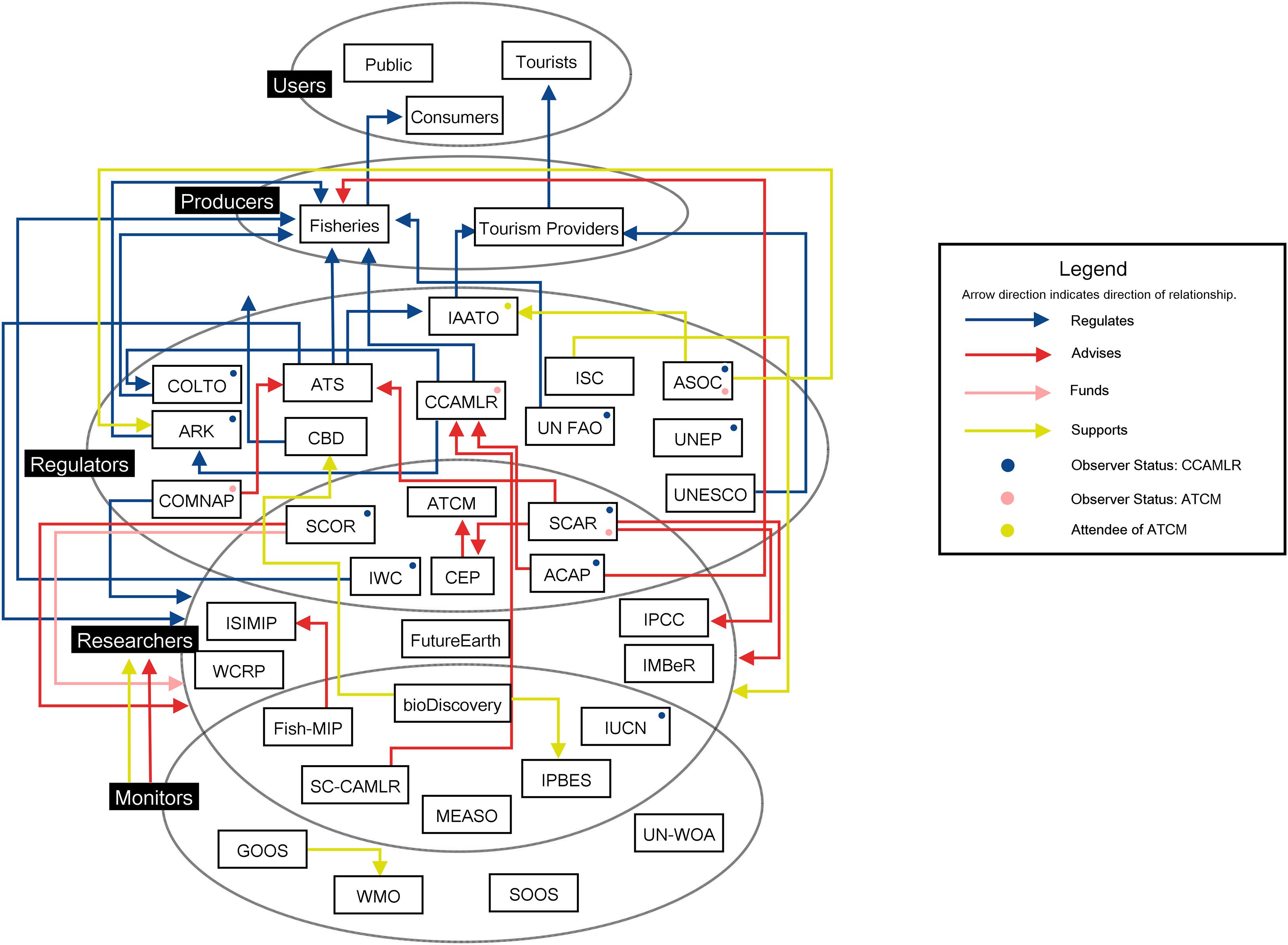
Figure 2. Network visualization of relationships between key stakeholders in Southern Ocean ecosystem management, grouped by their functional role in ecosystem management as per methods. Some individual stakeholders do not have direct connections to other stakeholders, although their parent stakeholder groups, labeled as black text boxes, are connected with other stakeholder groups or with individual stakeholders.
Applying the Values-Rules-Knowledge Framework
To contextualize the relationships between stakeholders and ecosystem services, we applied the vrk framework to three case studies of Southern Ocean ecosystem management, following Gorddard et al.’s (2016) approach. The vrk framework, aims to explore the interconnections between values, rules and knowledge in decision-making, to identify assumptions and gaps in decision-making systems and processes (Gorddard et al., 2016). It also explores vrk interactions, allowing for the analysis of the relationship and impact between values and rules, values and knowledge, and rules and knowledge (Gorddard et al., 2016; Table 2).
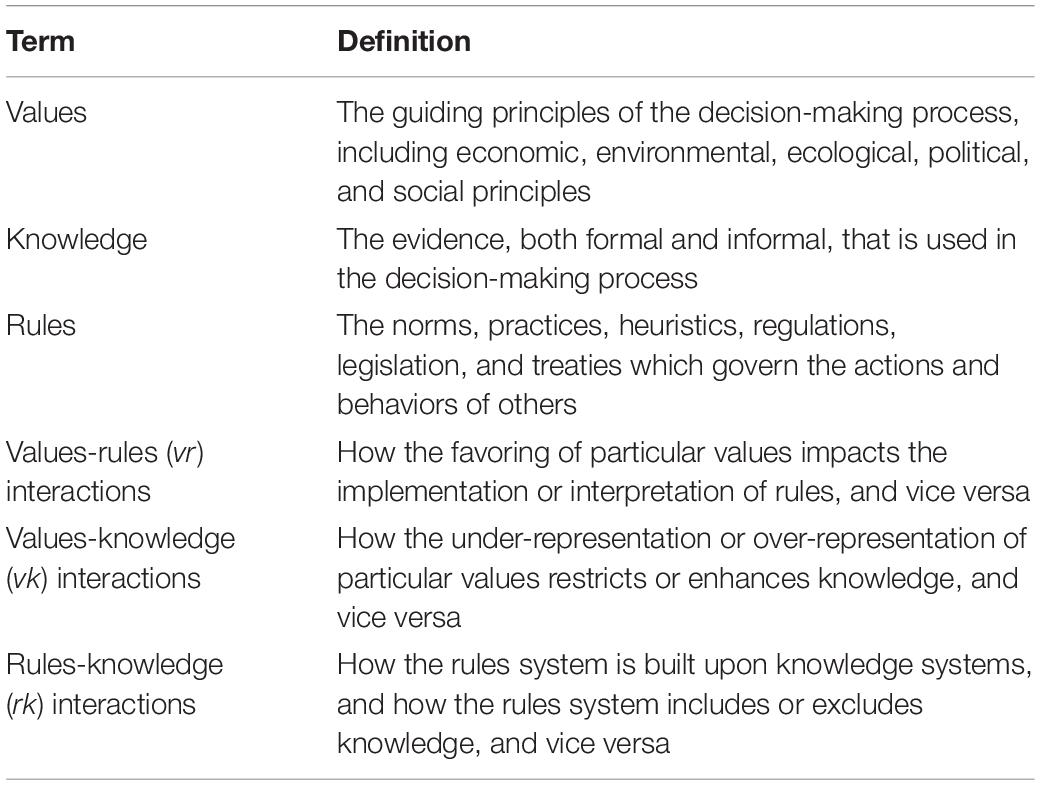
Table 2. A summary of the key terms used in the vrk framework (Gorddard et al., 2016).
We selected three diverse examples relating to Southern Ocean ecosystem management as case studies, to understand gaps in decision-making through the vrk framework.
(1) Commission for the CCAMLR Working Group on Incidental Mortality Associated with Fishing (WG-IMAF), which aimed to reduce seabird bycatch and death through fishing in the Southern Ocean (Commission for the Conservation of Antarctic Marine Living Resources, 2007). This example is subsequently referred to as IMAF.
(2) CCAMLR Marine Protected Area (MPA) declaration for the Ross Sea Region (Commission for the Conservation of Antarctic Marine Living Resources, 2017), subsequently referred to as Ross Sea MPA.
(3) Work to consider the biophysical, governance, and policy dimensions of potential iron fertilization in the Southern Ocean research as a geo-engineering approach for climate change mitigation (Charette et al., 2013; Institute for Marine and Antarctic Studies [IMAS], 2019), referred to as Fe fertilization.
These case studies were chosen to contrast different approaches in Southern Ocean ecosystem management, pertaining to different ecosystem components (1-seabirds, 2-whole-of-ecosystem, 3-primary production). The first two case studies were also selected due to high information availability. We note that while the third case study is not ecosystem management per se, it has a strong link to regulating services provided by Southern Ocean ecosystems, as well as complex challenges for governance and policy, and so was selected as a useful complement to the first two case studies.
We explored each case study by reviewing a combination of primary documents published by the respective body, as well as academic literature evaluating any relevant management decisions. The case studies were analyzed to understand their aims, methods, motivation, social-political context, participants and roles, following the recommended approach of Gorddard et al. (2016). We used this information to then ascertain underlying values, rules and knowledge implicit in the decision-making process. Finally, vr, vk, and rk interactions were explored by critically examining the values, rules and knowledge used in each case study. The process of case study analysis was conducted by one researcher, the vrk framework applied to the output by two researchers, and the overall process scrutinized by the authors’ team as a whole. To visually represent this information, we developed a conceptual diagram (Figure 4) to connect key stakeholders and ecosystem services for each case study, framed through the role each stakeholder played in the decision-making process.
Results
Stakeholders and Ecosystem Services
Our analysis of the transactional landscape for Southern Ocean ecosystem stakeholders and ecosystem services indicates that, across the different stakeholder groups, the strongest interest is in provisioning ecosystem services, followed by regulating services (Figure 1; see Table 3 for a list of acronyms in this and subsequent figures). All stakeholder groups have at least some interest in provisioning services, and all groups but fisheries have an interest in regulating services. In contrast, the only stakeholders with an interest in supporting ecosystem services are science research stakeholders, and the majority of the interest in cultural ecosystem services is held by the tourism and public groups (see Supplementary Table 2 for the full categorization of each stakeholder and details regarding their interest in and influence over ecosystem services).
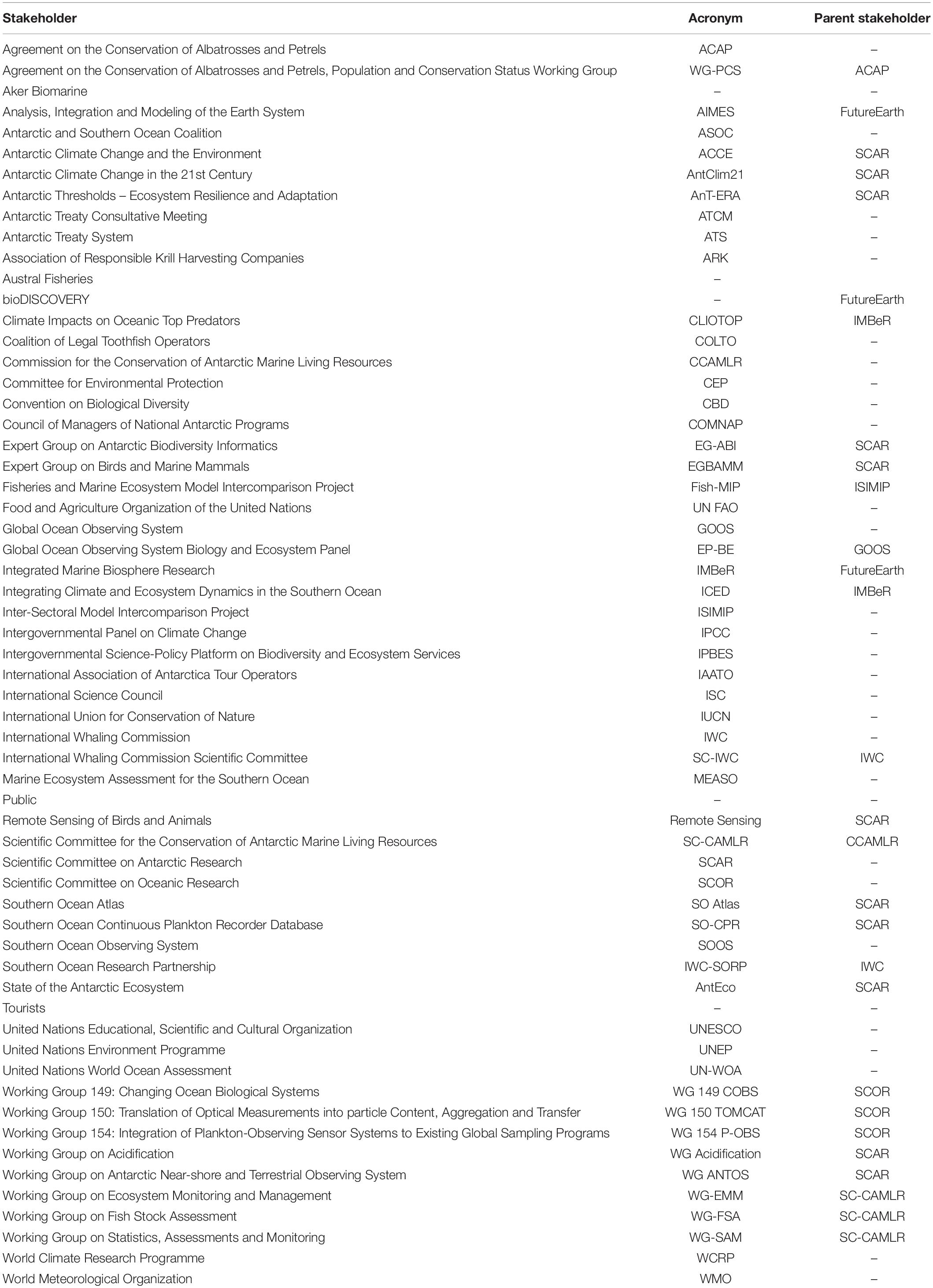
Table 3. Full list of identified stakeholders in Southern Ocean ecosystem management, including their parent stakeholder (if applicable), and definitions of acronyms for stakeholder groups as used in Figures 1, 2, 4 and Supplementary Table 2.
86.9% of ecosystem services relationships are to regulators, researchers, and monitors, with only 13.1% of producer or user relationships between stakeholders and ecosystem services. As a result, there may be an overrepresentation of science viewpoints and values in Southern Ocean ecosystem management decision-making.
Stakeholder Relationships
Four key types of relationships were identified between stakeholders in Southern Ocean ecosystem management: regulating, advising, funding, and supporting. Producers, in particular the fisheries industry, are the stakeholder group whose actions and behaviors are most governed by the regulator stakeholder group (Figure 2). Some researchers, as well as regulators themselves, are also regulated by other stakeholders.
There appears to be a strong culture of advising among the stakeholders, with many researchers advising regulators, particularly CCAMLR and ATS. Several researchers and regulators have observer status at CCAMLR or ATCM. This allows them to represent their perspectives at decision-making forums. No producers and only one monitor (IUCN) has either observer status or attends CCAMLR or ATCM, suggesting a potential gap in these stakeholder perspectives in decision-making.
Decision-Making Pathways
Despite the interconnectedness of stakeholders demonstrated in the stakeholder relationships network (Figure 2), the decision-making pathway is distinct, and represents the way in which the value of ecosystem services feeds into decision-making via government, science, and governance, and how users and producers impact ecosystem services (Figure 3). This conceptual diagram is applicable to Southern Ocean ecosystem management, as well as ecosystem management on a broader scale.
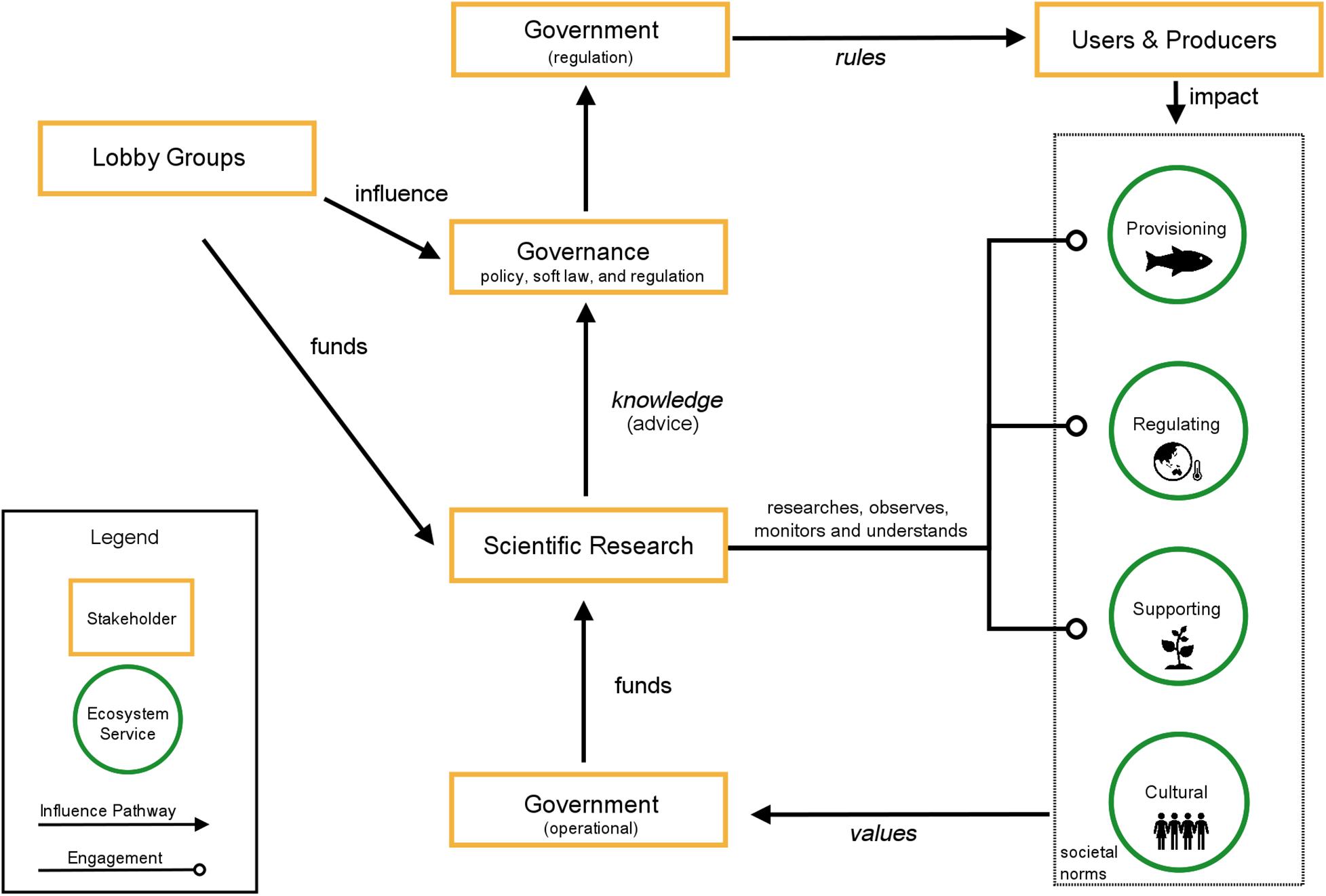
Figure 3. Conceptual representation of decision-making pathways in Southern Ocean ecosystem management, between various stakeholders and ecosystem services. Here, government performs two roles: as a funder and supporter of science, and as a regulator of users and producers. Knowledge, rules and values are italicized to indicate their role as components of the vrk framework.
Government performs two roles: as the primary funder and supporter of science, and as a regulator of users and producers. In the first instance, government is guided by cultural ecosystem services, which influence what areas of science are funded and otherwise supported. In the case of Southern Ocean ecosystem management, the influence of cultural ecosystem services on funding may differ between nations; some may be more strongly influenced by the values of the Southern Ocean, while others are likely to be more driven by domestic influences. However, the influence of different values may differ based on whether these decisions play out at a national or international level.
Governance takes three forms – policy, soft law, and regulation – and receives scientific advice based on scientific research, which is formulated through engagement with provisioning, regulating and supporting ecosystem services. Governance is also influenced by the actions and priorities of lobby groups.
Values-Rules-Knowledge (vrk) Case Studies
The vrk framework analysis of three Southern Ocean ecosystem management case studies is summarized in Table 4, and a network visualization particular to the ecosystem services and stakeholders represented in the case studies is shown in Figure 4. This network visualization demonstrates the dual role of science, in researching ecosystem services directly and in IMO, SCAR, and COMNAP providing scientific advice to other stakeholders. In this network visualization, researcher relationships are shown only for scientific research conducted specifically for the case study. Researchers in the Ross Sea MPA case study did not conduct any new research, but engaged only with the existing global body of scientific evidence; for this reason, science researchers are not shown to have a researcher relationship with any ecosystem service. We acknowledge the importance of individual nations as stakeholders in the Ross Sea MPA case study, so have considered four particular CCAMLR member states as stakeholders because of their roles in how decisions were made in this case study.
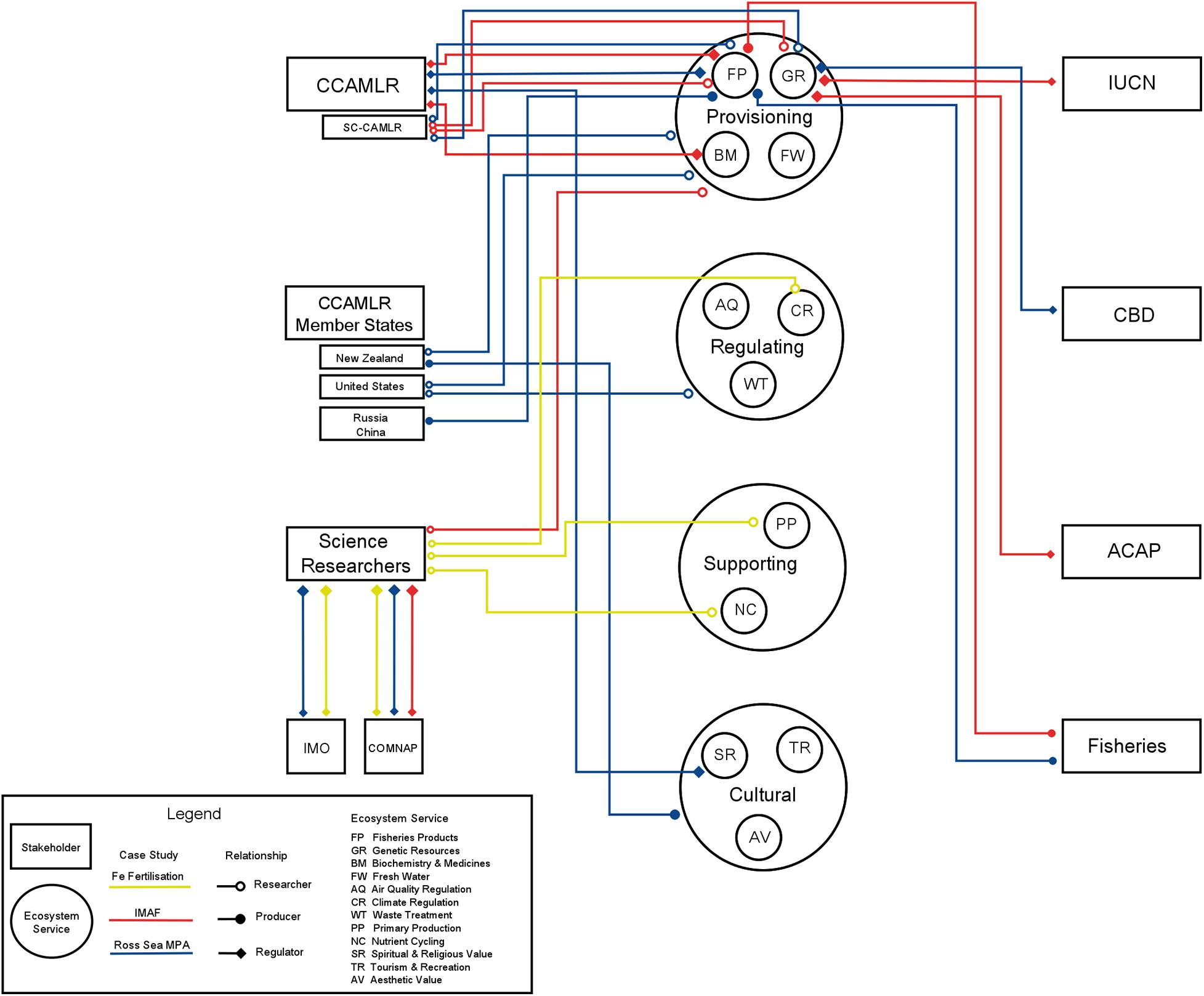
Figure 4. Relationships between key stakeholders and ecosystem services in three Southern Ocean ecosystem management case studies. Note that IMO and COMNAP regulate science researchers for the listed case studies (as IMO and COMNAP do not regulate the ecosystem services directly).
Values-Rules Interactions
The remit of CCAMLR is the conservation of Antarctic marine living resources (Press et al., 2019). However, fisheries have been given most of the attention of CCAMLR since the beginning (e.g., Constable, 2011).
Case study 1 emerged with the recognition of high rates of seabird mortality in longline fisheries in the early 1990s, which coincided with rapid declines in those populations. In order to rectify this, decision-making in IMAF initially heavily prioritized ecological and environmental values over social and economic values (Table 4). However, as incidental mortality of seabirds was reduced to zero, conservation measures were loosened to allow fisheries more freedom in operating, suggesting a growing shift toward increasing priority for economic values, although noting that ecological values still take precedent (Croxall, 2008; Waugh et al., 2008).
Case study 2 highlighted the challenges within CCAMLR of addressing questions of biodiversity conservation and the maintenance of supporting ecosystem services. The consensus decision process in CCAMLR and the large number of fishing interests amongst its Members means that provision services have higher attention than supporting services, such as biodiversity. Although the proposal of the Ross Sea MPA was based on ecological values, there was strong prioritization of economic values in the negotiation of the MPA’s boundaries, such that in its adopted form, some of the most productive areas of the Ross Sea remain unprotected, to allow fisheries to operate in these areas (Brooks, 2013; Brooks et al., 2019; Commission for the Conservation of Antarctic Marine Living Resources, 2017; Dodds and Brooks, 2018; Sylvester and Brooks, 2020).
Case study 3 provides an example external to CCAMLR but governed by an international convention that has regulatory power – the London Convention (International Maritime Organization [IMO], 2012). The assessment process for Fe fertilization is guided by science, giving regulators time to understand how to incorporate potential Fe fertilization in the Southern Ocean into carbon markets and international laws (Powell, 2008; Institute for Marine and Antarctic Studies [IMAS], 2019). However, the scientific research framework does not directly include exploration of the important ethical considerations in intervening in the earth’s biogeochemical cycles (because these were out of scope of the research project).
Values–Knowledge Interactions
CCAMLR has a remit from its Convention to use the best scientific evidence available (Constable et al., 2000; see also CCAMLR Resolution 31).
Case study 1 is an example of formal knowledge being prioritized over informal knowledge. The risk rating for seabirds in different fisheries, and therefore degree of risk management, for IMAF was based on published scientific information and expert information from CCAMLR’s Scientific Committee and its working groups, particularly on breeding ranges, at-sea distribution – both ecological values – to judge potential overlap with fisheries (Commission for the Conservation of Antarctic Marine Living Resources, 2007). It did not use or rely on knowledge from fisheries or conservation NGOs.
Case study 2 shows the tension between knowledge and values and how, in a consensus environment, some values can be diminished in consideration. Most specific knowledge in the Ross Sea has been developed for advising on toothfish fisheries. Yet, there is a large body of general scientific knowledge indicating its value to global scientific research and for supporting services such as biodiversity and productivity. While the latter would be expected to be given support to be sustained, the dominance of fisheries interests meant that non-ecological values, particularly economic values, were given increasing priority as the MPA declaration process progressed (Sylvester and Brooks, 2020). Through the consensus structure of CCAMLR, Member States have the power to prioritize their own values rather than pursuing satisfactory outcomes across all values.
Case study 3 emerged from a global opposition to uncontrolled waste disposal by dumping in the ocean, recognizing the impacts that pollution has on marine ecosystem services generally. The focus on scientific modeling and critically assessing the ecological and economic dimensions of Fe fertilization gives scientists time to explore unknown variables. Under the circumstances of this convention, regulators require confidence before acting that Fe fertilization will be effective and that any environmental effects are acceptable. In this particular example, social, political, and ethical values have not been considered directly to date.
Rules-Knowledge Interactions
Case study 1 on IMAF is a clear case where the rules system was built upon the scientific knowledge system, with all reviews of the CCAMLR Conservation Measure (CM) based on satisfactory reduction (elimination) of seabird by-catch. All public discussion is therefore framed around the CMs and by-catch data (Table 4). Scientific and ecological knowledge is prioritized through the rule that all longline vessels fishing in the area must have an independent scientific observer on board who reports on the implementation of the CMs. This is enforced through required compliance with by-catch reduction strategies being part of some fishery permits. Existing fisheries demand a high level of proof of the need and success for new management strategies before enacting them; this knowledge was considered in the implementation of the CM, with an initial focus on enforcing the CMs on new and exploratory fisheries before targeting existing fisheries (Waugh et al., 2008).
Case study 2 on the Ross Sea MPA has a close relationship between maintenance of the MPA and scientific research and monitoring built into the long-term application of the conservation measure. It remains to be seen how science and knowledge will be used in the maintenance of the MPA.
Case study 3 on Fe fertilization has a close relationship between scientific knowledge and future regulation, where both national and international policy and future scientific research will be developed based on environmental and economic analysis. This means it may exclude sociopolitical perspectives in formulating guidelines and rules. Globally, the current focus on ocean fertilization is to generate scientific knowledge, following the 2008 London Convention and London Protocol agreement that legitimate scientific research is the only permitted ocean fertilization activity (International Maritime Organization [IMO], 2012). Although this enables scientific research, this may restrict the participation of stakeholders who bring other knowledge sources, or do not engage in traditional scientific research.
Discussion and Conclusion
Information about stakeholder aspirations is a fundamental requirement for effective ecosystem-based management (Cavanagh et al., 2016). A key precursor to understanding these aspirations is an understanding of who the stakeholders are for a particular context and how they are connected to ecosystems and ecosystem services. For Southern Ocean ecosystems, consideration of this ‘transactional landscape’ has generally been constrained to specific issues, such as the management of the Southern Ocean krill fishery (Cavanagh et al., 2016) or implementation of marine protected areas (Sylvester and Brooks, 2020). In this study we have used structured, network-based approaches to consider the full stakeholder landscape for Southern Ocean ecosystems, to consider the ways in which stakeholders relate to different ecosystem services (Figure 1), as well as the way in which stakeholders are connected to each other (Figure 2). This process has yielded important insights into how different ecosystem services are understood, valued and managed, as well as a conceptual framework for how different types of stakeholders fit into and influence decision making pathways for Southern Ocean ecosystems (Figure 3). By combining this analysis of the transactional landscape with consideration of the role of values, rules and knowledge in particular examples that relate to decision making for Southern Ocean ecosystems, we are able to further highlight where gaps may exist that could be given greater consideration to support robust decision-making in the future.
Our results indicate that ecosystem science facilitates high connectivity between stakeholders and provisioning services, but that there is relatively limited connectivity between stakeholders and supporting services. This gap is likely to become increasingly important as dependencies on climate regulation services, in particular, increase in the future. Our application of Gorddard et al.’s (2016) ‘values-rules-knowledge’ framework to three case studies suggests that, at least in these cases, the emphasis for decision making has been on knowledge and rules. While this helps establish how to use the best scientific information in consensus decision-making, wider consideration of values across the broader stakeholder landscape (including individual nations) – together with science (knowledge) and governance (rules) – might provide greater appreciation of impediments to consensus when scientific information indicates the need to change the status quo (i.e., introduce regulations) in order to achieve agreed high-level objectives. Moreover, the type of mapping presented here can identify when some ecosystem services are being given greater short term priority, such as provisioning services, over the longer term requirements for sustaining others, such as supporting services. As a result, holistic mapping would be expected to improve whole-of-system sustainability.
We suggest that future stakeholder mapping might also usefully consider the influential role of particular nations in decision-making for Southern Ocean ecosystem services, particularly when analyzing the interests of fisheries, which all originate from nations and therefore act based on the conservation, economic and social priorities and aspirations of those nations. In the interest of keeping our analysis reasonably constrained, this nation-level analysis was deemed to be beyond the scope of our paper.
Case Study Findings With Respect to Values-Rules-Knowledge
Management to reduce incidental mortality of seabirds in the Southern Ocean (our IMAF case study) is commonly heralded as a successful collaborative conservation project (Croxall, 2008), while the MPA declaration in the Ross Sea region was arguably less successful, given its size had to be decreased in order for it to be adopted (Sylvester and Brooks, 2020). Our analyses suggest that a factor influencing this outcome was the role of social and political values in the MPA negotiation process (as opposed to values around all ecosystem services). Political and social values were successfully considered through the IMAF management process, by focusing implementation based on the values of different sub-sets of fisheries (Croxall, 2008). Although political and ethical values are acknowledged in research relating to potential geo-engineering through iron fertilization in the Southern Ocean, they are not explored directly as part of the research. Assessment of ethical and political aspects of iron, alongside ecological and economic assessment, might help ensure that scientific knowledge can be successfully implemented in rules whilst navigating trade-offs in political, ethical and economic values.
Across the three case studies analyzed, the stakeholders engaged were heavily invested in provisioning ecosystem services (Figure 4). This is in line with our analysis of the stakeholders across Southern Ocean ecosystem management more generally (Figure 1). The Ross Sea MPA process involved stakeholders who have an interest across three different ecosystem services; however, our analysis suggests that working with stakeholders who are interested in a variety of ecosystem services must be coupled with incorporating many different values in order for management decision-making to be more successful in collaboration and conserving the ecosystem.
Stakeholder Engagement for Southern Ocean Ecosystem Decision-Making Under Climate Change
The need for effective management and robust decision-making for Southern Ocean ecosystems will become more important as the global climate continues to change (Constable et al., 2017; Meredith et al., 2019; Cavanagh et al., 2021). The impacts of climate-driven environmental changes pose current and future risks for most Southern Ocean ecosystem services, and these risks will need to be managed to meet increasing demand for fisheries products, tourism and regulating services. Understanding and considering the perspectives, needs and roles of diverse stakeholders in these processes will lead to more robust outcomes for ecosystems and people. Our study is the first to characterize the full transactional landscape for Southern Ocean ecosystem services and stakeholders, and we hope that our analyses, particularly as they relate to emphases and gaps in previous processes, might help underpin effective ecosystem management under future climate change in the Southern Ocean. A remaining challenge is to determine how representative stakeholders of the Southern Ocean are with respect to the wider expectations of civil society and whether the stakeholders can keep pace with their rapidly changing norms.
Key Messages to Policymakers
(1) To gain a holistic appreciation of how Southern Ocean ecosystem services are understood, valued and managed, it is essential to consider the full stakeholder landscape.
(2) There are many connections (indicating a high level of interest) between Southern Ocean stakeholders and provisioning ecosystem services (primarily fisheries), but more limited connectivity between stakeholders and supporting ecosystem services (primary production and nutrient cycling).
(3) This suggests that short term priorities may be given precedence over longer term priorities for overall Southern Ocean sustainability (such as supporting services).
(4) Bridging the gap between stakeholders and supporting ecosystem services will become increasingly important under climate change as the world increases its reliance on the Southern Ocean’s climate regulation services (since biological supporting services play a key role in global climate feedbacks).
(5) The emphasis for decision making in the Southern Ocean has been on knowledge and rules over values. Wider consideration of values across the full stakeholder landscape may help achieve consensus through science-informed decision-making.
Data Availability Statement
The original contributions presented in the study are included in the article/Supplementary Material, further inquiries can be directed to the corresponding author/s.
Author Contributions
JM-T and JS conceived the study. JS led the data collection and analyses. All the authors contributed to writing the manuscript.
Funding
This article was funded in part by CSIRO Oceans and Atmosphere and Monash University.
Conflict of Interest
The authors declare that the research was conducted in the absence of any commercial or financial relationships that could be construed as a potential conflict of interest.
Acknowledgments
We would like to thank Susie Ho for her support and coordination of the Monash University Masters of Environment and Sustainability, through which the research for this article was completed. We would also like to thank Stacey McCormack, Brett Stacy, and Laura Kaikkonen for their valuable feedback during the early stages of this work.
Supplementary Material
The Supplementary Material for this article can be found online at: https://www.frontiersin.org/articles/10.3389/fmars.2021.623733/full#supplementary-material
References
Antarctic Treaty System (2020). Antarctic Treaty. Available online at: https://www.ats.aq/ (accessed January 20, 2020).
Brooks, C. M. (2013). Competing values on the Antarctic high seas: CCAMLR and the challenge of marine-protected areas. Polar J. 3, 277–300. doi: 10.1080/2154896X.2013.854597
Brooks, C. M., Crowder, L. B., Österbloom, H., and Strong, A. L. (2019). Reaching consensus for conserving the global commons: the case of the Ross Sea, Antarctica. Conserv. Lett. 13:e12676. doi: 10.1111/conl.12676
Buck, H. J. (2014). Village Science Meets Global Discourse: the Haida Salmon Restoration Corporation’s Ocean Iron Fertilization Experiment. Case Study, Geoengineering Our Climate Working Paper and Opinion Article Series. Available online at: http://wp.me/p2zsRk-9M (accessed January 30, 2020).
Cavanagh, R. D., Hill, S. L., Knowland, C. A., and Grant, S. M. (2016). Stakeholder perspectives on ecosystem-based management of the Antarctic krill fishery. Mar. Policy 68, 205–211. doi: 10.1016/j.marpol.2016.03.006
Cavanagh, R. D., Melbourne-Thomas, J., Grant, S. M., Barnes, D. K. A., Hughes, K. A., Halfter, S., et al. (2021). Future risk for southern ocean ecosystem services under climate change. Front. Mar. Sci. 7:615214. doi: 10.3389/fmars.2020.615214
Charette, M. A., Gille, S. T., Sanders, R. J., and Zhou, M. (2013). Southern ocean natural iron fertilization. Deep Sea Res. II 90, 1–3. doi: 10.1016/j.dsr2.2013.04.014
Commission for the Conservation of Antarctic Marine Living Resources (2007). CCAMLR’s Work on the Elimination of Seabird Mortality Associated with Fishing. Available online at: http://archive.ccamlr.org/pu/E/sc/imaf/docs/CCAMLR_elimination%20of%20IMAF.pdf (accessed January 30, 2020).
Commission for the Conservation of Antarctic Marine Living Resources (2017). Conservation Measure 91-05 (2016). Available online at: https://www.ccamlr.org/en/measure-91-05-2016 (accessed January 28, 2020).
Commission for the Conservation of Antarctic Marine Living Resources (2018). Marine Protected Areas (MPAs). Available online at: https://www.ccamlr.org/en/science/marine-protected-areas-mpas (accessed January 29, 2020)
Commission for the Conservation of Antarctic Marine Living Resources (2019). Cooperation With Others. Available online at: https://www.ccamlr.org/en/organisation/cooperation-others (accessed October 22, 2020).
Constable, A. J. (2011). Lessons from CCAMLR on the implementation of the ecosystem approach to managing fisheries. Fish Fish. 12, 138–151. doi: 10.1111/j.1467-2979.2011.00410.x
Constable, A. J., De La Mare, W. K., Agnew, D. J., Everson, I., and Miller, D. (2000). Managing fisheries to conserve the Antarctic marine ecosystem: practical implementation of the convention on the conservation of antarctic marine living resources (CCAMLR). ICES J. Mar. Sci. 57, 778–791. doi: 10.1006/jmsc.2000.0725
Constable, A. J., Melbourne-Thomas, J., Trebilco, R., Press, A. J., and Haward, M. (2017). ACE CRC Position Analysis: Managing Change in Southern Ocean Ecosystems. Hobart, TAS: Antarctic Climate and Ecosystems Cooperative Research Centre.
Costanza, R., d’Arge, R., de Groot, R., Farber, S., Grasso, M., Hannon, B., et al. (1997). The value of theworld’s ecosystem services and natural capital. Nature 387, 253–260. doi: 10.1038/387253a0
Croxall, J. P. (2008). The role of science and advocacy in the conservation of Southern Ocean albatrosses at sea. Bird Conserv. Int. 18, S13–S29. doi: 10.1017/S0959270908000300
Dodds, K., and Brooks, C. M. (2018). Antarctic Geopolitics and the Ross Sea Marine Protected Area. Available online at: https://www.e-ir.info/2018/02/20/antarctic-geopolitics-and-the-ross-sea-marine-protected-area/ (accessed January 30, 2020).
Gannon, K. E., and Hulme, M. (2018). Geoengineering at the “Edge of the World”: exploring perceptions of ocean fertilisation through the Haida Salmon Restoration Corporation. GEO 5, e00054. doi: 10.1002/geo2.54
Gorddard, R., Colloff, M. J., Wise, R. M., Ware, D., and Dunlop, M. (2016). Values, rules and knowledge: adaptation as change in the decision context. Environ. Sci. Policy 57, 60–69. doi: 10.1016/j.envsci.2015.12.004
Grant, S. M., Hill, S. L., Trathan, P. N., and Murphy, E. J. (2013). Ecosystem services of the Southern Ocean: trade-offs in decision-making. Antarct. Sci. 25, 1–15. doi: 10.1017/S0954102013000308
Grimble, R., Chan, M.-K., Aglionby, J., and Quan, J. (1995). Trees and Trade-Offs: Astakeholder Approach to Natural Resource Management,” Gatekeeper SeriesNo. 52. London: International Institute for Environment and Development.
Horton, Z. (2017). Going rogue or becoming salmon? Geoengineering narratives in Haida Gwaii. Cult. Crit. 97, 128–166. doi: 10.5749/culturalcritique.97.2017.0128
Institute for Marine and Antarctic Studies [IMAS] (2019). ARC Laureate Fellowship: Geoengineering the Southern Ocean? A Transdisciplinary Assessment. Available online at: https://www.imas.utas.edu.au/home/home-features/arc-laureate-fellowship-geoengineering-the-southern-ocean-a-transdisciplinary-assessment (accessed January 30, 2020).
International Maritime Organization [IMO] (2012). Parties to International Dumping Treaties Express Concern Regarding Iron Fertilization Incident. Available online at: http://www.imo.org/en/MediaCentre/PressBriefings/Pages/47-ocean-fertilisation.aspx#.XjOVdFMzZFQ (accessed January 31, 2020).
International Maritime Organization [IMO] (2020). Ocean Fertilization under the LC/LP. Available online at: http://www.imo.org/en/OurWork/Environment/LCLP/EmergingIssues/geoengineering/OceanFertilizationDocumentRepository/OceanFertilization/Pages/default.aspx (accessed January 31, 2020).
Kavanagh, A. (2016). Ross Sea Designated as World’s Largest Marine Protected Area. Available online at: https://www.pewtrusts.org/en/research-and-analysis/articles/2016/10/28/ross-sea-designated-as-worlds-largest-marine-protected-area (accessed January 30, 2020).
Marine Protection Atlas. (2020). Ross Sea Region [General Protection Zone (ii) Seamount Range]. Available online at: https://mpatlas.org/zones/68813307/ (accessed January 30, 2020).
Meredith, M. P., Sommerkorn, M., Cassotta, S., Derksen, C., Ekaykin, A., Hollowed, A., et al. (2019). “Polar regions,” in IPCC Special Report on the Ocean and Cryosphere in a Changing Climate, eds H.-O. Pörtner, D. C. Roberts, V. Masson-Delmotte, P. Zhai, M. Tignor, and E. Poloczanska, K. Mintenbeck, A. Alegría, M. Nicolai, A. Okem, J. Petzold, B. Rama, N. M. Weyer (in press).
Millennium Ecosystem Assessment [MEA]. (2005). Ecosystems and Human Well-being: a Framework for Assessment. Washington DC: Island Press.
Miller, D. (2011). “Sustainable management in the Southern Ocean: CCAMLR science,” in Science Diplomacy: Science, Antarctica, and the Governance of International Spaces, eds P. A. Berkman, M. A. Lang, D. W. H. Walton, and O. R. Young (Washington, DC: Smithsonian Institution Scholarly Press), 103–121. doi: 10.5479/si.9781935623069.103
New Zealand Ministry of Foreign Affairs and Trade (2016). Agreement to Protect Ross Sea Reached. Available online at: https://www.beehive.govt.nz/release/agreement-protect-ross-sea-reached (accessed January 30, 2020).
Parkes, G. (2000). Precautionary fisheries management: the CCAMLR approach. Mar. Policy 24, 83–91. doi: 10.1016/S0308-597X(99)00015-9
Powell, H. (2008). Dumping iron and Trading Carbon. Available online at: https://www.whoi.edu/oceanus/feature/dumping-iron-and-trading-carbon/?id=35826 (accessed January 30, 2020).
Press, A. J., Hodgson-Johnston, I., and Constable, A. J. (2019). “The principles of the convention on the conservation of antarctic marine living resources: why its commission is not a regional fisheries management organisation,” in Governing Marine Living Resources in the Polar Regions, eds N. Liu, C. Brooks, and T. Qin (Cheltenham: Eward Elgar Publishing), 9–29. doi: 10.4337/9781788977432.00010
Raum, S. (2018). A framework for integrating systematic stakeholder analysis in ecosystem services research: stakeholder mapping for forest ecosystem services in the UK. Ecosyst. Serv. 29, 170–184. doi: 10.1016/j.ecoser.2018.01.001
Rogers, A. D., Frinault, B. A. V., Barnes, D. K. A., Bindoff, N. L., Downie, R., Ducklow, H. W., et al. (2020). Antarctic futures: an assessment of climate-driven changes in ecosystem structure, function, and service provisioning in the southern ocean. Annu. Rev. Mar. Sci. 12, 87–120. doi: 10.1146/annurev-marine-010419-011028
Seddon, N., Mace, G. M., Naeem, S., Tobias, J. A., Pigot, A. L., Cavanagh, R., et al. (2016). Biodiversity in the anthropocene: prospects and policy. Proc. R. Soc. B Biol. Sci. 283:1844. doi: 10.1098/rspb.2016.2094
Sylvester, Z. T., and Brooks, C. M. (2020). Protecting Antarctica through Co-production of actionable science: lessons from the CCAMLR marine protected area process. Mar. Policy 111:103720. doi: 10.1016/j.marpol.2019.103720
Trebilco, R., Melbourne-Thomas, J., and Constable, A. J. (2020). The policy relevance of Southern Ocean food web structure: Implications of food web change for fisheries, conservation and carbon sequestration. Mar. Policy 115:103832. doi: 10.1016/j.marpol.2020.103832
Keywords: stakeholder engagement, Southern Ocean, ecosystem services, knowledge values rules, transactional landscape, network mapping
Citation: Solomonsz J, Melbourne-Thomas J, Constable A, Trebilco R, van Putten I and Goldsworthy L (2021) Stakeholder Engagement in Decision Making and Pathways of Influence for Southern Ocean Ecosystem Services. Front. Mar. Sci. 8:623733. doi: 10.3389/fmars.2021.623733
Received: 30 October 2020; Accepted: 20 April 2021;
Published: 13 May 2021.
Edited by:
Philippe Archambault, Laval University, CanadaReviewed by:
Catarina Frazão Santos, University of Lisbon, PortugalPeter Convey, British Antarctic Survey (BAS), United Kingdom
Copyright © 2021 Solomonsz, Melbourne-Thomas, Constable, Trebilco, van Putten and Goldsworthy. This is an open-access article distributed under the terms of the Creative Commons Attribution License (CC BY). The use, distribution or reproduction in other forums is permitted, provided the original author(s) and the copyright owner(s) are credited and that the original publication in this journal is cited, in accordance with accepted academic practice. No use, distribution or reproduction is permitted which does not comply with these terms.
*Correspondence: Jess Melbourne-Thomas, Jess.Melbourne-Thomas@csiro.au
 Josh Solomonsz
Josh Solomonsz Jess Melbourne-Thomas
Jess Melbourne-Thomas Andrew Constable
Andrew Constable Rowan Trebilco
Rowan Trebilco Ingrid van Putten
Ingrid van Putten Lyn Goldsworthy
Lyn Goldsworthy